WORLD CLASS COACHING
Tactical Training Games
By Renato Lopez Moreira
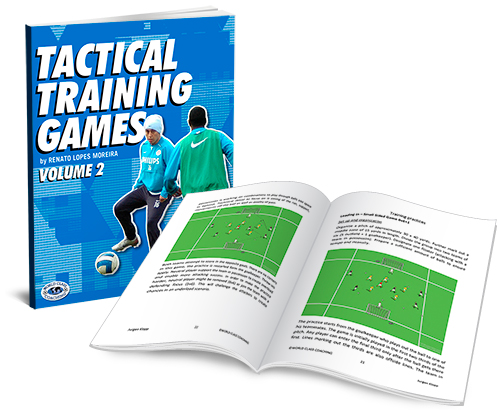
Table of Contents
PART ONE
Introduction
4v4 with 2v1 in Offensive areas
4v4 with 1 Goalkeeper in Offensive areas
2v2+2 Offensive game
5v5 Crossing game
5v5 Crossing game + 2 supporter players
PART TWO
5v5 game +4 supporter players
4v4+2 support players
5v5 Dummy game with free attack movement
5v5 game static game with free attack movement
1v1 + 2v2 game into areas
5v5 + 4 goals
1v1 Goal game (Winner stays on)
PART THREE
1v1 chaotic game with 4 Goals
2v2 game with 2v1 offensive game into areas
7v7 game touches between the areas
4v1 dynamic game
5v2 dynamic game (Pass and touch the cone)
6v6 + 4 goals
4v4 + 4 goals
4v4 + 2 goals
6v6x6 transition game
3v3 + 1 support player (Find the middle)
PART FOUR
6v6 Transition Game
5v5 Transition game with a 5v4 initial game situation
5v5 Holding ball game
5v5 Holding ball game + 2 Goals
INTRODUCTION
In this book we are going to show some tactical games that will help you with your training sessions.
It's common knowledge that soccer is a basic Attack v Defense game. The team who has the ball organizes his actions and the team who doesn’t have the ball organizes to recover it.
It's also common knowledge that a soccer game involves 22 players, 11 players for each team, playing in a 105x68 meters game field. But it's very difficult to see a 11v11 game situation or even a 10x10 game situation happening during a game today. Players have less space to play and it's easy to see a lot of players in the same space during a game disputing the ball.
In soccer games today, more often you see situations like 6v6 game situation in a 40 meters game area. The coach has to be prepared to train his team to play in situations like these.
The idea of this book is to show some exercises that work in these small situations and coaches can implement in their training sessions.
The basic principles of a soccer game are:
(a) Try to create majority of players;
(b) Avoid equality of players;
(c) Deny inferiority of players.
To understand these basic principles players have to know the tactical structure of soccer and understand the reasons for some actions.
So, what are tactics?
Tactics are fundamental elements that give dynamics to the game, giving sense to the soccer game.
Tactics are also the decisions the players make during a game, with or without the ball, in an individual or collective way.
Tactics can be divided into two principles that order the players' actions during a game:
(a) General: Equality (equal numbers), majority (numbers-up) or minority (numbers-down) situations involving the players in the areas of the ball;
(b) Specific: Group of rules that direct players' action on both phases of the game, offensive and defensive, with the objective to unbalance the opponent's defense.
These principles lead us to tactical capacity which is directly related to the players:
(a) Individual: One player does an isolated action to reach a goal defined by the coach. The 1v1 game situation is the best example for highlighting this capacity.
(b) Small Group: Two or three players do a sequence of actions to reach a goal defined by the coach. 2v2, 2v3, 3v3, 3v2 game situation can be examples for developing this capacity.
(c) Team: Four or more players do a sequence of actions to reach a goal defined by the coach. 4v3, 4v4, 5v4, 5v5, 6v5 game situations can be examples for developing this capacity.
These capacities lead us to some tactical actions that might be done during the offensive and defensive phases in a game:
(a) Offensive actions:
. Penetration;
. Offensive coverage;
. Mobility;
. Space creation;
. Offensive unit.
(b) Defensive actions:
. Contention;
. Defensive coverage;
. Balance;
. Concentration;
. Defensive unit.
All of these will be converted to operational principles of a soccer game, which are:
(a) Offensive phase:
. Maintain ball possession;
. Build offensive plays;
. Advance to the field;
. Create situations to finish;
. Finish to the opponent’s goal.
(b) Defensive phase:
. Recover ball possession;
. Reduce the space into the field;
. Prevent opponent’s advance;
. Prevent opponent’s finishing situations;
. Protect the goalkeeper.
With all this presentation about tactics we now can talk about the exercises of this book.
With all the principles and actions above, soccer can be considered a complex game which is represented by an 11v11 game situation. But if you try to think and prepare your team only having this situation in your mind it will be very difficult to do.
The idea here is to simplify this, presenting situations involving most current situations that happen during a game.
Here you will see some 1v1, 2v2, 3v3, 4v4, 5v5, 6v6, 7v7 game exercises involving majority (numbers-up), minority (numbers-down), transition, and all offensive and defensive principles shown above. And all these exercises will be played in a maximum 70 meters and a minimum 9 meters game area, adapting to soccer reality nowadays.
Here we have 27 games to improve your small confrontations during all the soccer game areas and phases.
And in all you will play in a smaller space, just like a real game.
They involve some exercises that you might use in your warmup or even during the main part of your training. And all exercises have some variations that you can apply and vary during the preparation of your team.
All these exercises were applied, tested, modified and thought out to give me what I wanted for my team. And they can be applied at any time of the season. You just have to adapt their volume and intensity.
I hope this material can be shared with other coaches around the world just like they have shared with me.
Good reading and good studying.
Renato.
4v4 with 2v1 in Offensive areas:
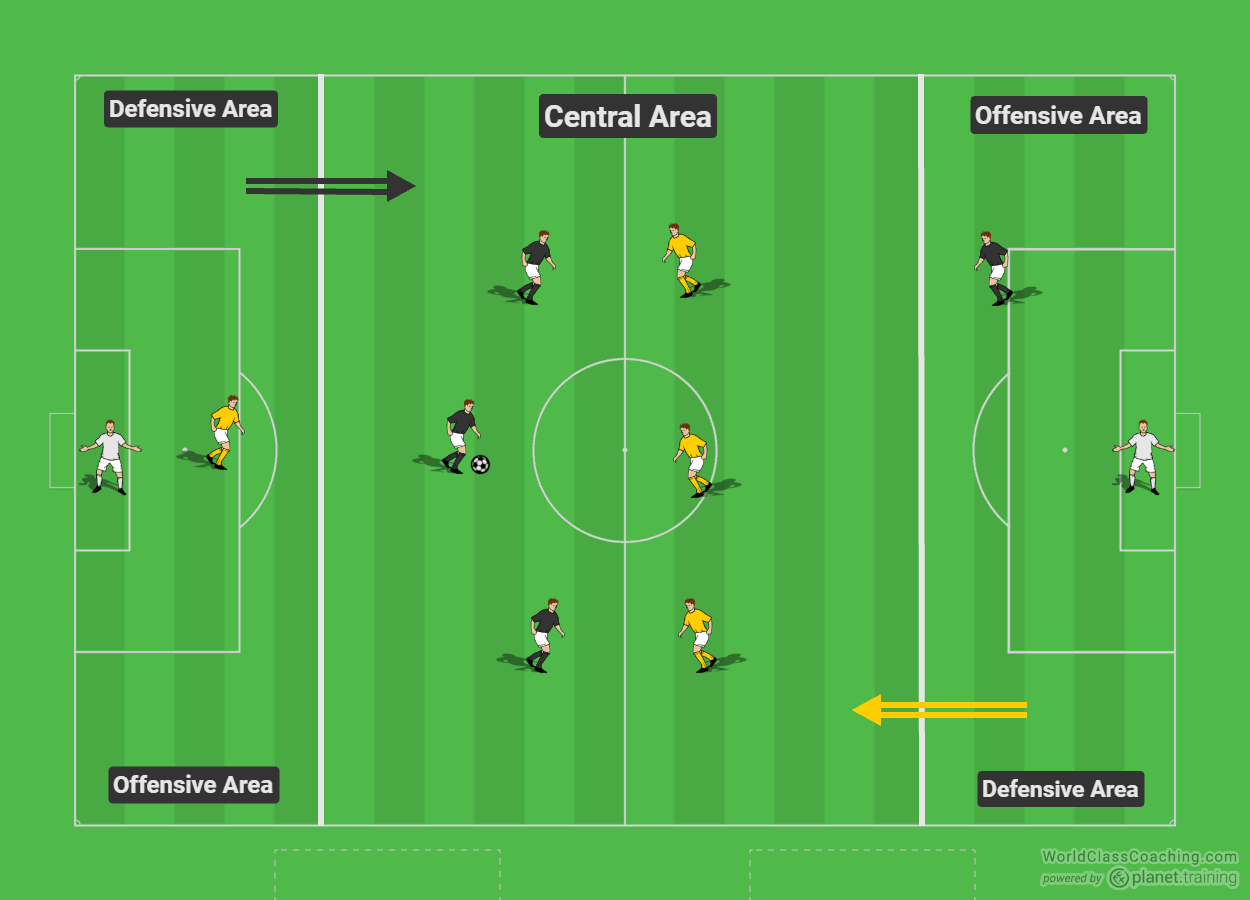
Setup:
10 players
A 40x20 meters game field.
Execution:
Divide the field into 3 areas:
(a) A defensive one;
(b) A central one;
(c) A offensive one.
Put 3 players into the central area and 1 player of each team in the offensive area.
The game happens in the central area and the objective is to pass the ball to the offensive area in a coordinated way.
The player who makes the pass to the offensive area can advance to shoot, while just one defender can go there and try to stop the attack.
Then you have a 2v1 offensive situation in the offensive area.
If the defense recovers the ball possession, they can counter attack.
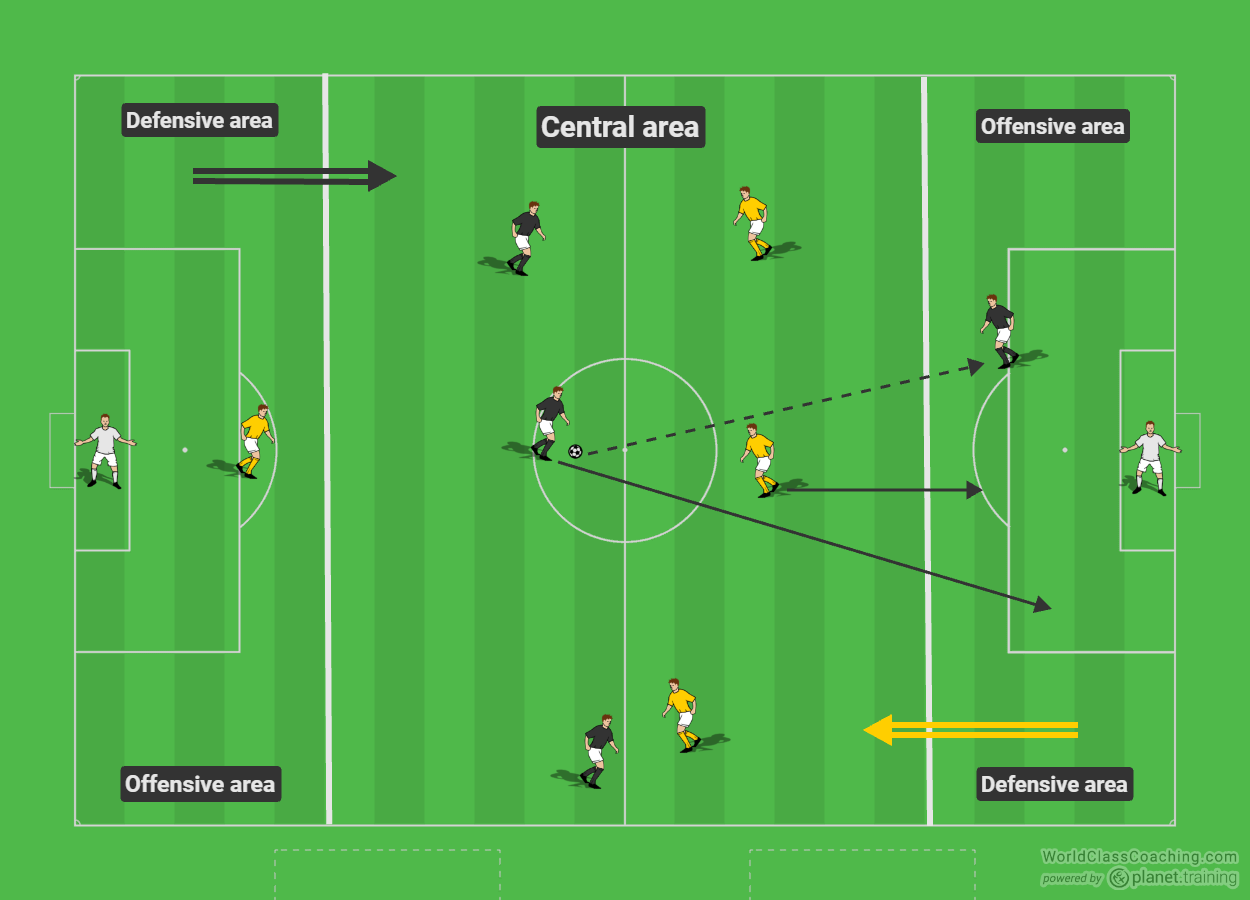
Variations:
. You can increase or decrease the number of players involved;
. You can increase the game field area;
. You can increase the number of players on each area;
. You can vary the game situations, creating a 3v2, 4v3, 5v4, etc.
. You can define the type of ball passed into the offensive area;
. You can vary the area’s size.
4v4 with 1 Goalkeeper in Offensive areas:
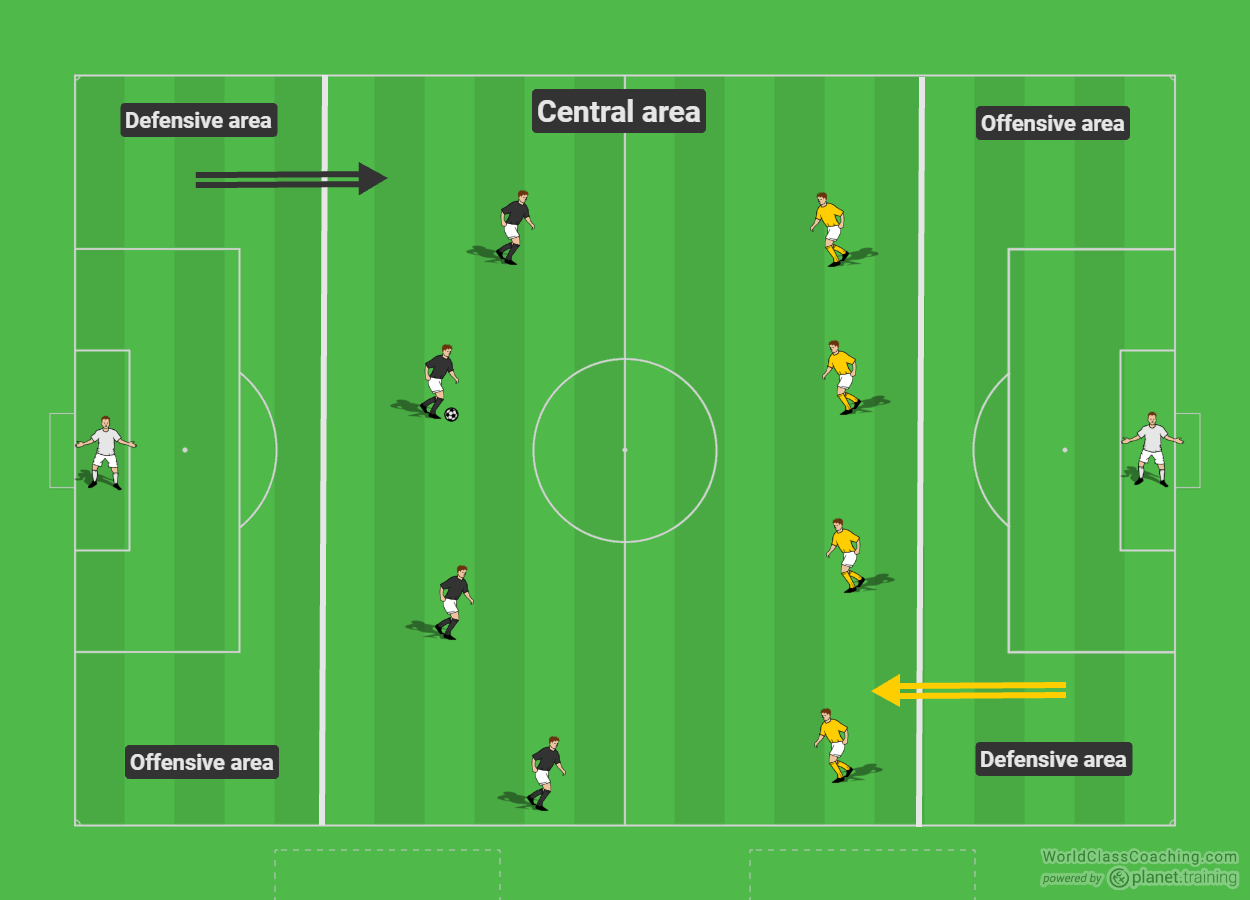
* This exercise can be a variation of the 4v4 game with 2v1 situation in Offensive areas.
Setup:
10 players
A 30x20 meters game field.
Execution:
Divide the field into 3 areas:
(a) A defensive one;
(b) A central one;
(c) A offensive one.
Put 3 players into the central area and the exercise start with a 4v4 game situation.
The game happens in the central area and the objective is to pass the ball to the offensive area with a vertical pass.
The attack has to carry the ball into the offensive area. They can do this dribbling or touching the ball with a vertical pass.
Only one player can enter the offensive area during the attack.
No defender can enter this area, leaving the Goalkeeper in a 1v1 situation.
If the Defense recovers the ball, they have the counter attack.
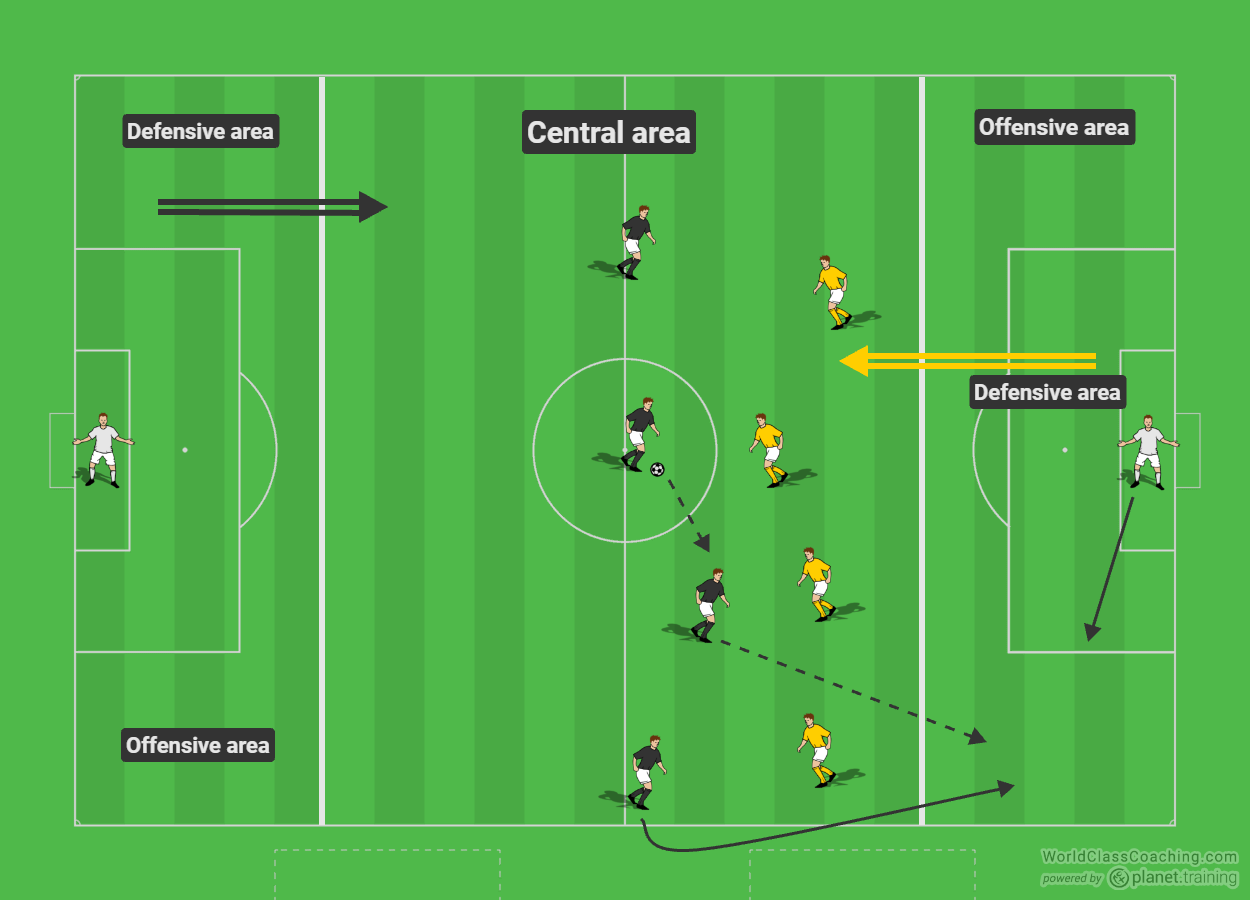
Variations:
. You can increase or decrease the number of players involved;
. You can increase the game field area;
. You can vary the game situations, creating a 3v2, 4v3, 5v4, etc.
. You can define the type of ball pass to the offensive area;
. You can vary the area’s size.
2v2+2 Offensive game:
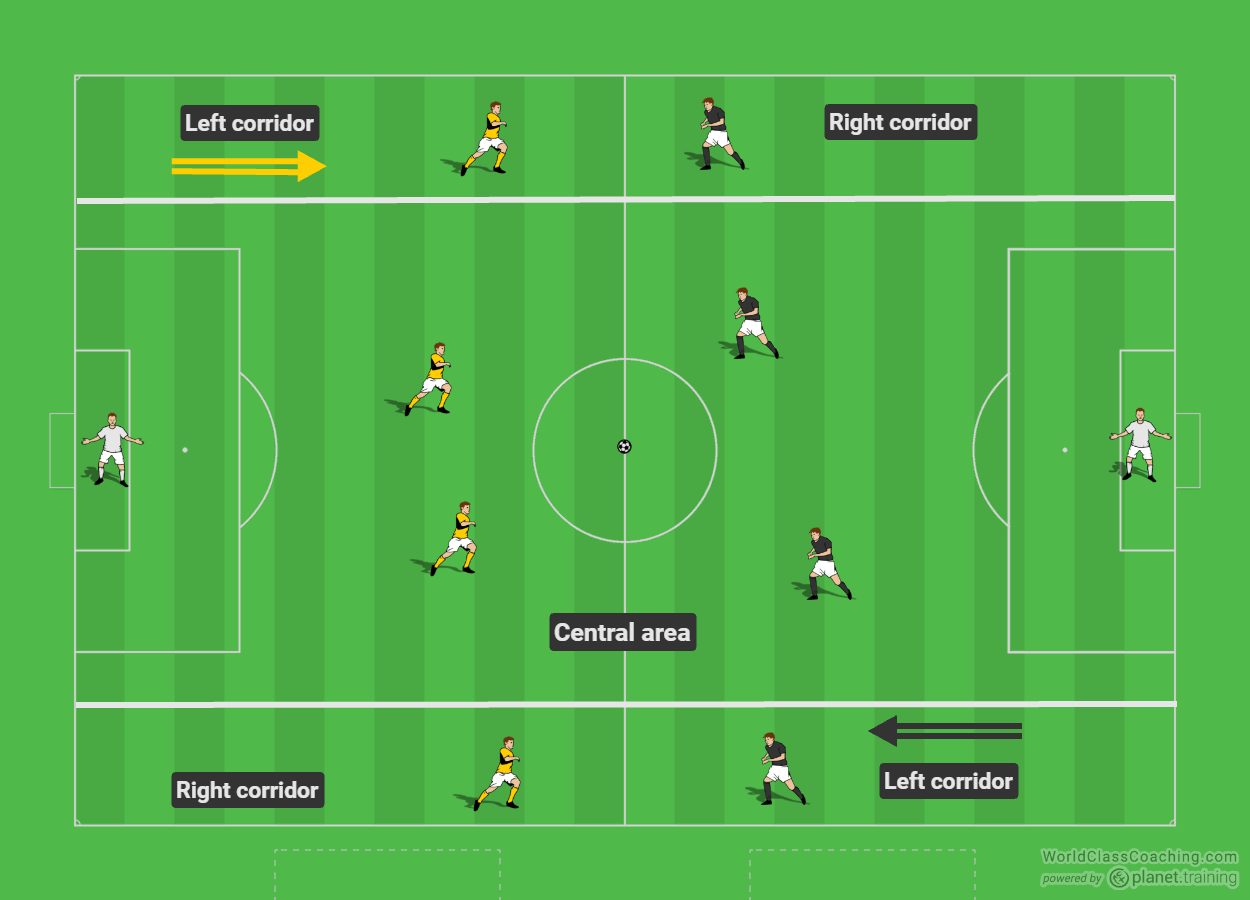
Setup:
10 players
A 40x20 meters game field.
Execution:
Divide the field into 3 areas:
(a) A Central one;
(b) A Left corridor;
(c) A Right corridor.
Divide the players into the 3 corridors leaving 2 players of each team in the Central area and 2 players on each corridor.
The game happens inside the central area with a 2v2 situation.
The attack can use the left and right backs’ support while they have the ball.
During the attack you have a 4v2 situation.
If the defense recovers the ball possession they automatically start to counter attack and can use their left and right backs.
The defense is not allowed enter into the left and right corridors.
The left and right backs are allowed to move freely into the corridors.
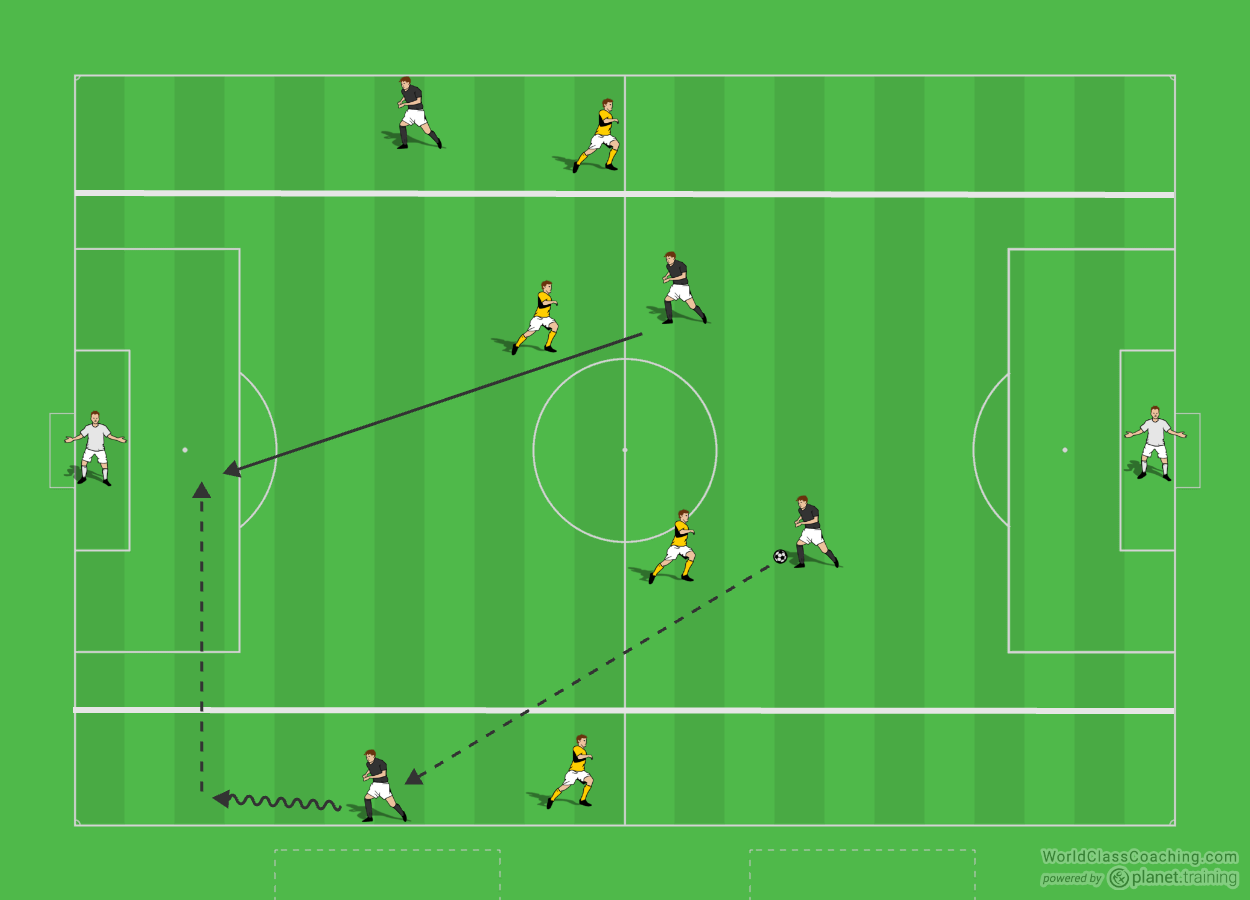
Variations:
. You can increase or decrease the number of players involved;
. You can increase or decrease the game field area;
. You can allow marking in corridors;
5v5 Crossing game:
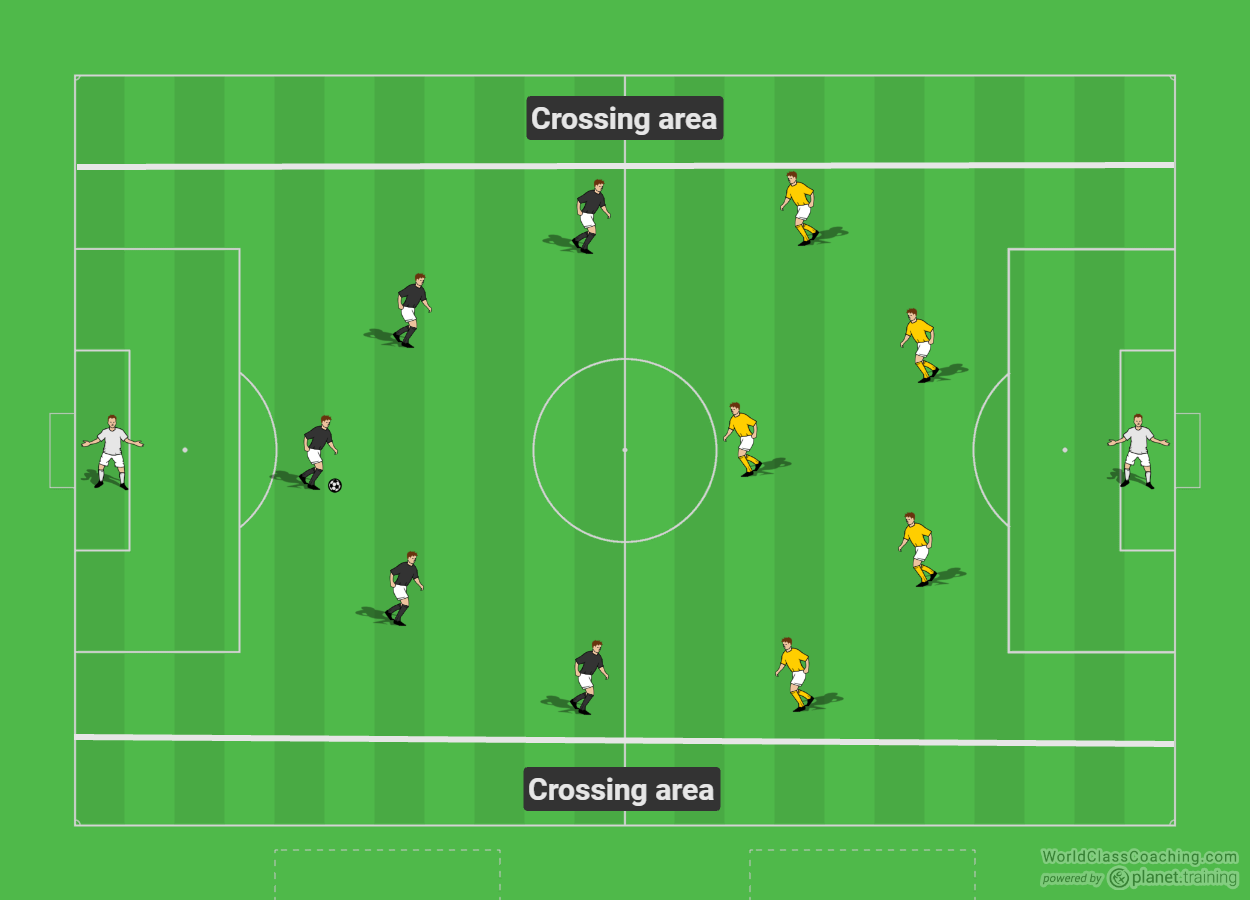
* This exercise can be a variation of the 2v2+2 Offensive game
Setup:
12 players
A 50x35 meters game field
Execution:
Divide the field into 3 areas:
(a) A Central area;
(b) A Left corridor;
(c) A Right corridor.
Put all the players into the Central area and start the exercise with a 5v5 game situation.
The attack can use the left and right corridors while they have the ball.
Only one player can enter at any corridor to play.
The goal will only be valid if the ball comes from a cross.
No defender is allowed to enter into the corridors to defend.
If the defense recovers the ball possession they automatically start to counter attack and can use their left and right corridors.
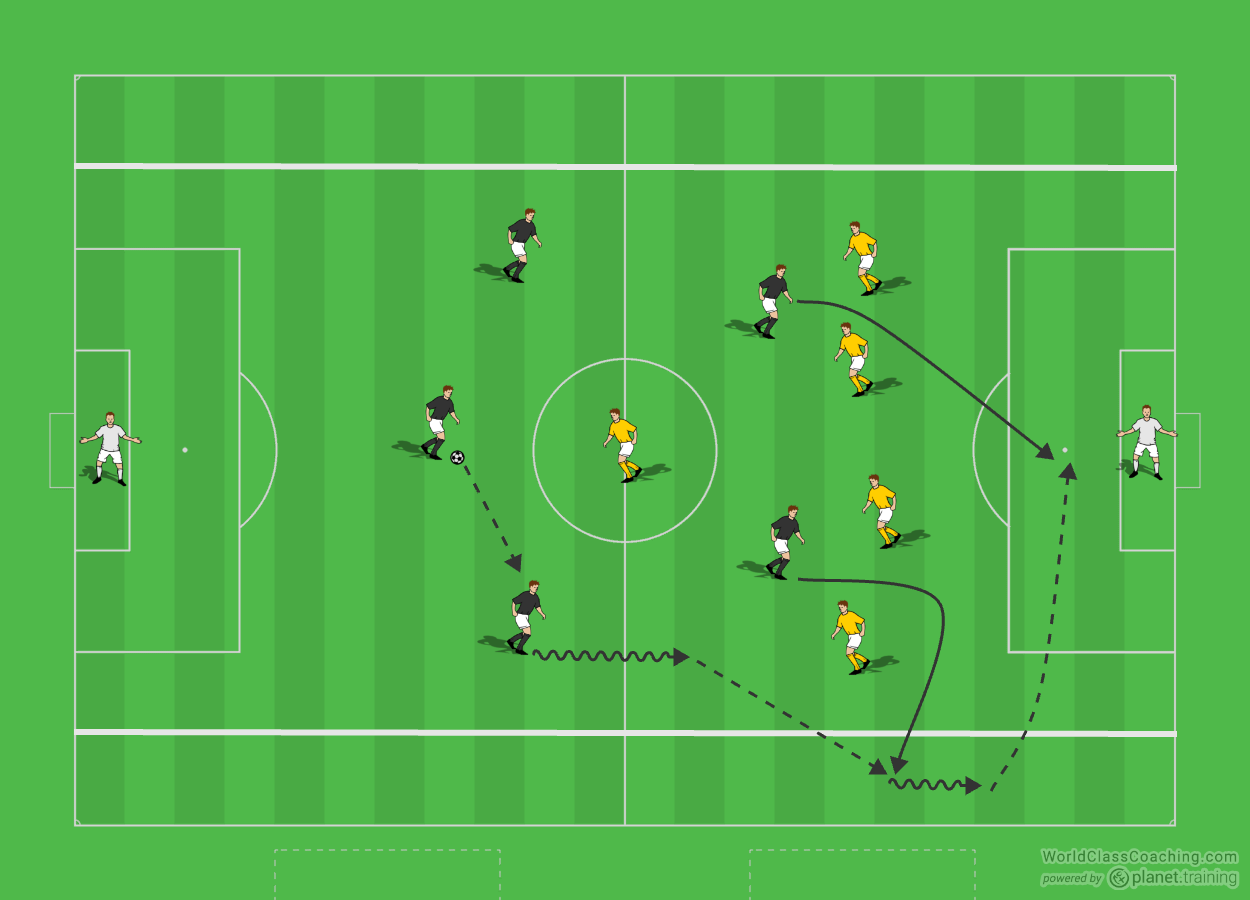
Variations:
. You can increase or decrease the number of players involved;
. You can increase or decrease the game field area;
. You can allow marking on corridors;
. You can vary the type of crossings;
. You can allow shots outside the corridors.
5v5 Crossing game + 2 supporter players:
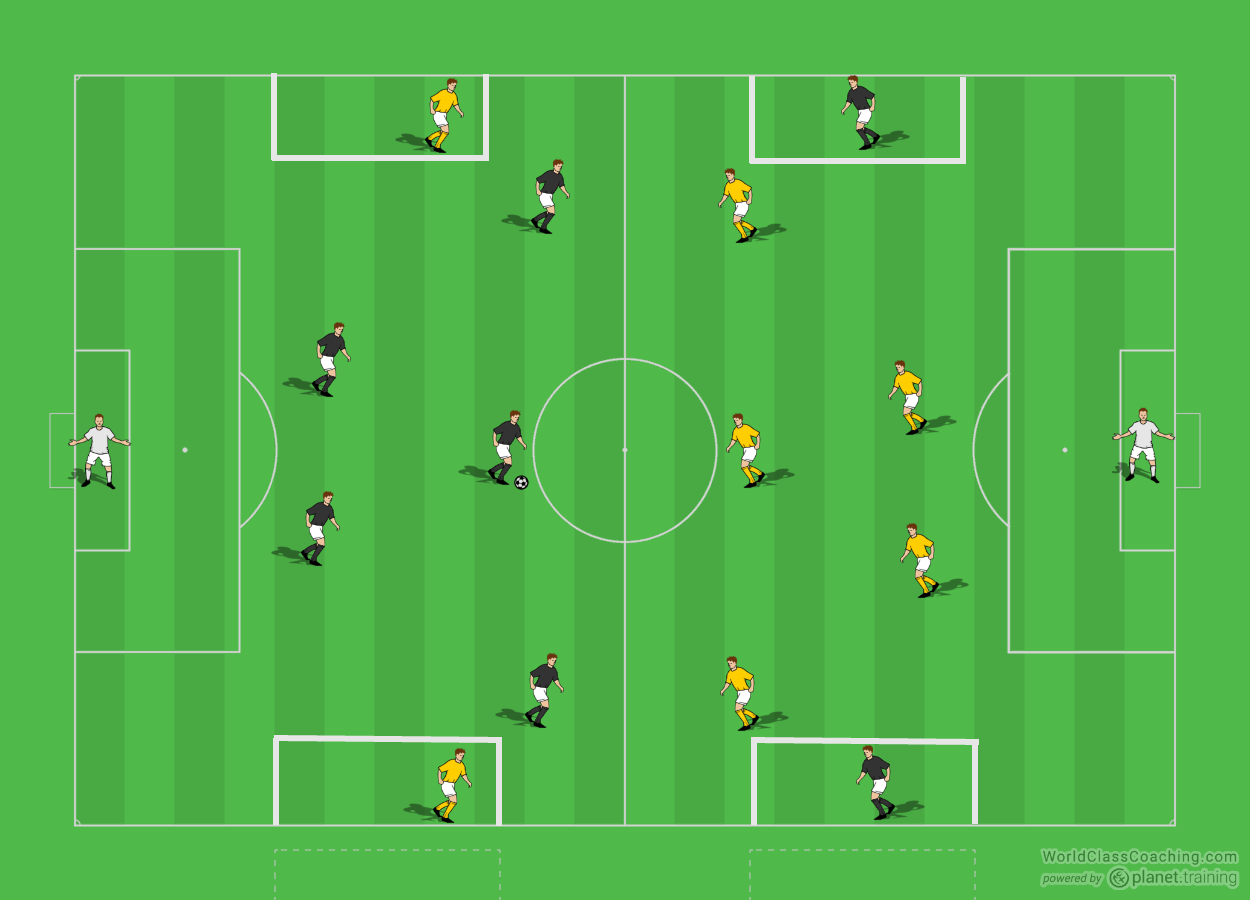
* This exercise can be a variation of the 2v2+2 Offensive game and 5v5 Crossing game.
Setup:
16 players
A 60x40 meters game field
Execution:
You will create four crossing areas on the game field--two crossing areas in each offensive field.
Each crossing area will be 3v2 meters.
Put one player of each team inside one crossing area and start the exercise with a 5v5 game situation.
The players inside crossing areas cannot leave their area.
The goal will only be valid if it the ball comes from a cross.
No defender is allowed to enter into the corridors to defend.
If the defense recovers the ball possession they automatically start to counter attack and can use their left and right corridors.
Variations:
. You can increase or decrease the number of players involved;
. You can increase or decrease the crossing areas;
. You can vary the location of the crossing areas;
. You can start the exercise with the crossing areas empty.


